Traditional Colombian Dances You Should Know About

Colombians love to dance: it’s practically their favourite thing! And contrary to popular belief, there are a lot more types of dance in Colombia than just salsa and reggaeton, as the country is home to myriad musical genres, each of which has its own distinctive dance and rhythm. So here are some traditional Colombian dances you might not know about, but should.
Cumbia
Cumbia is one of the most enduringly popular genres in Colombia; a folkloric style dating back to the colonial period on the Caribbean coast, cumbia is played on drums, flutes, and percussion instruments of African and indigenous origins. The dance is a wonderful spectacle to behold. Mimicking a traditional courtship ritual, women wearing long, colourful skirts circle around men in traditional outfits – white clothes and a regional sombrero.
Porro
Porro is another Caribbean music genre – originating in the region of Sucre – which imitates big band or military marching music. It’s a much livelier and faster dance than the comparatively sedate cumbia style and has gradually taken on elements of other dances, such as cumbia and salsa, over the years. The best places to experience Porro – which has enjoyed a renaissance in popularity since the 1980s – is the Festival del Porro in San Pelayo and the Festival del Porro in Medellin.
Bambuco
Moving to the Andean regions of Colombia, and you’ll find Bambuco: one of the most important and influential dances in the country. While it is much less fashionable these days, it has impacted many other more modern dances and cultural forms. With a beat structure similar to a European waltz or polska, Bambuco is usually a couple’s dance: a type of sensual waltz, with only brief, delicate moments of contact between dancers.
https://youtube.com/watch?v=8DOOPFVZsEw
Champeta
A dance and genre strongly inspired by the African heritage of many people on the Caribbean coast, champeta has become one of the most popular styles of music and dance among young people in Colombia. It’s a deeply sensual and seductive style that a person can dance alone or with a partner, and it has developed a reputation as an especially provocative Colombian dance style.

Joropo
Similar to the more famous Fandango, Joropo is a dance and musical style that comes from Colombia’s vast eastern plains, or Llanos Orientales. The dance is similar to a waltz, with the dancers first holding onto one another, before separating and performing a movement that has often been compared to sweeping the floor.
Salsa Choke
Remember Colombia’s players dancing during their World Cup 2014 win over Greece? It captured the hearts of many neutrals, and the dance they were doing was none other than the salsa choke. A relatively new genre from the Pacific region of Tumaco, salsa choke mixes Afro-based rhythms and traditional salsa with reggaeton. It became famous in Cali – Colombia’s salsa capital – and world famous thanks to James Rodriguez and company in Brazil. Check out the dance moves for salsa choke in the wildly popular video for Cali Flow Latino’s ‘Swagga’ below.
Bullerengue
A type of dance from the Caribbean coastal regions of Colombia, bullerengue is one of the Colombian dances and genres most closely tied to the area’s African heritage. Traditionally, only women – who are normally dressed entirely in white – perform this dance, which is meant to be symbolic of female fertility. The rhythm of bullerengue dancing is always defined by the drums, and the dancers usually clap to complement the beats and the rhythm.













